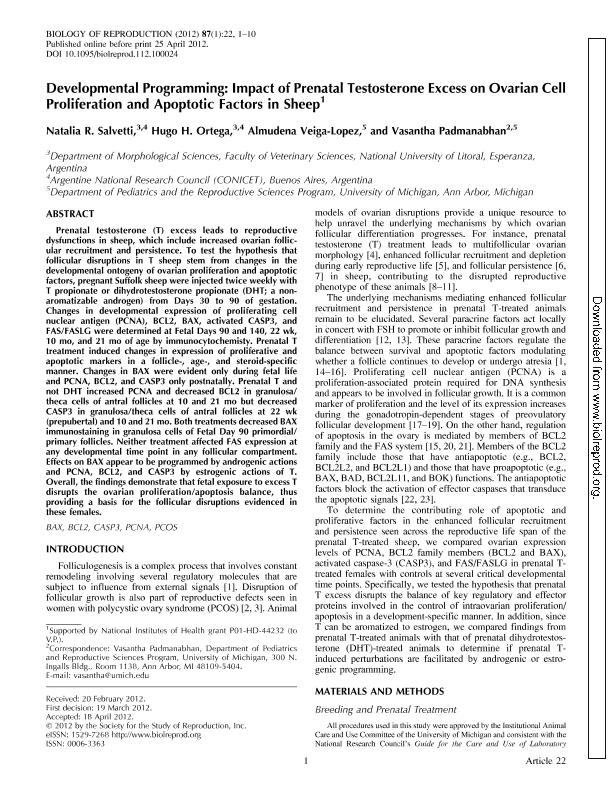Mostrar el registro sencillo del ítem
dc.contributor.author
Salvetti, Natalia Raquel

dc.contributor.author
Ortega, Hugo Hector

dc.contributor.author
Veiga Lopez, Almudena
dc.contributor.author
Padmanabhan, Vasantha

dc.date.available
2023-10-30T15:43:14Z
dc.date.issued
2012-03
dc.identifier.citation
Salvetti, Natalia Raquel; Ortega, Hugo Hector; Veiga Lopez, Almudena; Padmanabhan, Vasantha; Developmental programming: Impact of prenatal testosterone excess on ovarian cell proliferation and apoptotic factors in sheep; Society for the Study of Reproduction; Biology of Reproduction; 87; 1; 3-2012; 1-10
dc.identifier.issn
0006-3363
dc.identifier.uri
http://hdl.handle.net/11336/216430
dc.description.abstract
Prenatal testosterone (T) excess leads to reproductive dysfunctions in sheep, which include increased ovarian follicular recruitment and persistence. To test the hypothesis that follicular disruptions in T sheep stem from changes in the developmental ontogeny of ovarian proliferation and apoptotic factors, pregnant Suffolk sheep were injected twice weekly with T propionate or dihydrotestosterone propionate (DHT; a nonaromatizable androgen) from Days 30 to 90 of gestation. Changes in developmental expression of proliferating cell nuclear antigen (PCNA), BCL2, BAX, activated CASP3, and FAS/FASLG were determined at Fetal Days 90 and 140, 22wk, 10 mo, and 21 mo of age by immunocytochemisty. Prenatal T treatment induced changes in expression of proliferative and apoptotic markers in a follicle-, age-, and steroid-specific manner. Changes in BAX were evident only during fetal life and PCNA, BCL2, and CASP3 only postnatally. Prenatal T and not DHT increased PCNA and decreased BCL2 in granulosa/ theca cells of antral follicles at 10 and 21 mo but decreased CASP3 in granulosa/theca cells of antral follicles at 22wk (prepubertal) and 10 and 21 mo. Both treatments decreased BAX immunostaining in granulosa cells of Fetal Day 90primordial/ primary follicles. Neither treatment affected FAS expression at any developmental time point in any follicular compartment. Effects on BAX appear to be programmed by androgenic actions and PCNA, BCL2, and CASP3 by estrogenic actions of T. Overall, the findings demonstrate that fetal exposure to excess T disrupts the ovarian proliferation/apoptosis balance, thus providing a basis for the follicular disruptions evidenced in these females.
dc.format
application/pdf
dc.language.iso
eng
dc.publisher
Society for the Study of Reproduction

dc.rights
info:eu-repo/semantics/openAccess
dc.rights.uri
https://creativecommons.org/licenses/by-nc-sa/2.5/ar/
dc.subject
BAX
dc.subject
BCL2
dc.subject
CASP3
dc.subject
PCNA
dc.subject
PCOS
dc.subject.classification
Endocrinología y Metabolismo

dc.subject.classification
Medicina Clínica

dc.subject.classification
CIENCIAS MÉDICAS Y DE LA SALUD

dc.title
Developmental programming: Impact of prenatal testosterone excess on ovarian cell proliferation and apoptotic factors in sheep
dc.type
info:eu-repo/semantics/article
dc.type
info:ar-repo/semantics/artículo
dc.type
info:eu-repo/semantics/publishedVersion
dc.date.updated
2023-04-20T16:09:58Z
dc.journal.volume
87
dc.journal.number
1
dc.journal.pagination
1-10
dc.journal.pais
Estados Unidos

dc.journal.ciudad
Madison
dc.description.fil
Fil: Salvetti, Natalia Raquel. Consejo Nacional de Investigaciones Científicas y Técnicas; Argentina. Universidad Nacional del Litoral; Argentina
dc.description.fil
Fil: Ortega, Hugo Hector. Consejo Nacional de Investigaciones Científicas y Técnicas; Argentina. Universidad Nacional del Litoral; Argentina
dc.description.fil
Fil: Veiga Lopez, Almudena. University of Michigan; Estados Unidos
dc.description.fil
Fil: Padmanabhan, Vasantha. University of Michigan; Estados Unidos
dc.journal.title
Biology of Reproduction

dc.relation.alternativeid
info:eu-repo/semantics/altIdentifier/doi/http://dx.doi.org/10.1095/biolreprod.112.100024
dc.relation.alternativeid
info:eu-repo/semantics/altIdentifier/url/https://www.ncbi.nlm.nih.gov/pmc/articles/PMC3406557/
dc.relation.alternativeid
info:eu-repo/semantics/altIdentifier/url/https://academic.oup.com/biolreprod/article/87/1/22,%201-10/2514031?login=false
Archivos asociados
